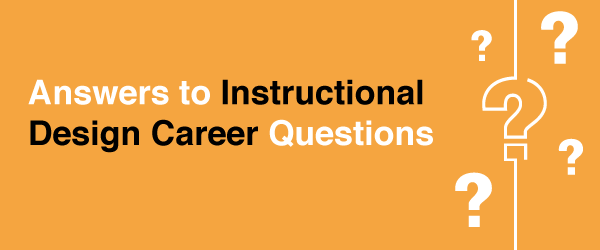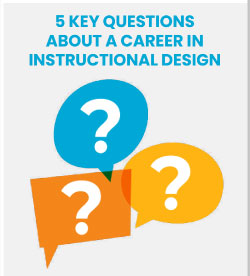
I get lots of emails from people who are considering a career in instructional design. In fact, that’s why I created a free 12-lesson email course called Breaking into Instructional Design. It’s all about the career.
In this article, I provide a summary of the answers I’ve given to common instructional design career questions. Keep in mind that I provide only one perspective and that it’s important to get other opinions. That said, here are common questions I’ve been asked followed by
1. I’m an experienced teacher but would like to transition into a career in instructional design. Do you think I can find a job?
What Instructional Designers Do
Although a teacher’s skills overlap with those of an instructional designer, there are gaps you will need to close. A typical career in instructional design focuses on solving workplace performance problems rather than helping students learn in a classroom environment. Instructional designers in the workplace typically design and support experiences that help people gain proficiency in work-related skills. Instructional designers in higher education typically work with faculty to put their courses online and sometimes, to ensure their courses are instructionally sound.
Will it fulfill you?
In a Learning and Development environment, you could spend much of your time behind a computer or in collaborative meetings with stakeholders, subject matter experts, and team members. You may interact with sample members of the audience during the design and development process, but there is much less engagement with learners than when teaching. So first, think about whether you would find this type of work fulfilling. An alternative might be to seek work as a trainer or facilitator.
Professional Development or Certificates
Your background is a good start—you have spent time thinking about how people learn and seeing the world from their perspective. To close any skill gaps, consider professional development courses or university certificate programs that provide a foundation in learning science and instructional design. See my list of Instructional Design Programs and scroll down for the certificate programs.
I created a membership community, Mastering Instructional Design, for people of all skill levels to learn and build instructional design skills. In a community, you may be surprised at how the social learning aspect can accelerate your progress. Many members are also enrolled in university programs and find my courses to be complementary and more practical than those in academia.
Portfolios
I would also recommend building an online portfolio. This allows you to demonstrate how you can solve specific workplace problems by including an analysis, design and storyboard documents in your portfolio. If you are interested in the tech side too, then add samples of your technology-based work (eLearning, learning portals, mobile learning, etc.). See How to Develop an Instructional Design Portfolio for more depth on this.
Networking
Finally, think about ways you can network with others in the field. Join a professional association like The Learning Guild and/or ATD. ATD has chapters in most larger cities in the US. Join a LinkedIn or Facebook group: Instructional Design Newbies (my group), Instructional Designers in Education and The Learning Guild are a few that come to mind.
2. Should I go back to school and get a second Masters in Instructional Design? I already have a Masters in ______ .
This is a personal decision, but I’m assuming you’d rather not go back to graduate school. If that’s the case, I’d encourage you to find a professional development or university certificate program instead, which is a much shorter path. Then on your resume and portfolio, emphasize the skills you have from your work experience and education. Instructional Design is multi-disciplinary, so many fields overlap with it. These include: writing, communication, IT, education, UX, graphic design, video production, business, and probably a few more. Learn how to talent stack your skills to fit in with the instructional design field.
3. How can I get my first job in instructional design? All the listings ask for three years of experience.
It must be very frustrating to finish school or a professional development program and then find it difficult to get a job. I recommend several strategies for these situations:
- Create a portfolio (see above)
- Volunteer your instructional design services to organizations that you support
- Try to use instructional design skills at your current job (is there a problem you can solve with training?)
- Get to know the Learning and Development team in your organization, if that exists
- Increase the time you spend networking. Look for organizations and events in your country. ATD has many chapters around U.S. cities.
- Network online by joining one of the larger LinkedIn groups for instructional designers and stay active. Create a personal learning network through social media (you can connect with me on Twitter via @elearningcoach). Also, listen to this Finding a Job in Instructional Design for advice on getting a job in instructional design.
4. I went for an interview for an instructional design position, because I’ve been developing training for years. The company wants a portfolio. What does that mean?
Similar to an artist’s portfolio, the hiring company wants to see examples of what you’ve done in the field. Pull together the best of your training plans, design documents, storyboards, manuals, and anything you have that shows how you shine.
Here are five relevant articles or series about portfolios. Some are several years old, so technical information may need to be updated.
- How to Build an Instructional Design Portfolio (my article referenced previously)
- Building Your eLearning Portfolio by Mike Taylor
- Instructional Design Portfolio Resources by Christy Tucker
- What to Include in an eLearning Portfolio by Trina Rimmer
- 10 Tips to Help You Build Your eLearning Portfolio by Melissa Milloway
5. What instructional design graduate program do you recommend?
I’m not in a position to know which program will work for your goals, so I suggest you look through my list of graduate and certificate programs and inquire at the ones that interest you. It also includes a few undergraduate programs too. For any program, check that the curriculum has the career focus you’re looking for: higher education, workplace (corporate) Learning & Development, or K-12 ed tech. Note that Learning Design and Instructional Design programs tend to focus on workplace training and Educational Technology degrees tend to focus on schools and school systems.
Also, check that the full curriculum seems up-to-date and includes a foundation in cognitive psychology or learning theory as well as practical skills. Once you find several programs that may suit you, do your research to find out if:
- There are graduates that you can speak to about the program
- They provide assistance finding employment in your field after graduation
- Particular industries hire their graduates. Industry-oriented programs is discussed in this podcast episode: Educating the New Instructional Designer.
Also, consider joining one of the larger instructional design LinkedIn groups to ask members if they would recommend the programs you are considering. Most people in this field are incredibly helpful and will recommend their favorites.
6. I’m looking into getting a certificate in Adult Education. Is that the best route for a career in instructional design? And what about those short professional courses?
It’s difficult to tell what a program will include by its title. I would suggest a program that provides a foundation in learning science, instructional design processes, and requires hands-on experience in designing and building a variety of learning experiences. If the Adult Education certificate does not meet your needs, search for certificates in instructional design, learning experience design, or instructional technology, to name a few. See my list of programs and scroll down for the certificate programs. I’m sorry that the list is US-based, but many programs are virtual anyway.
Short professional courses may be sufficient if you have experience or background knowledge in the field already. I also offer a way to take professional development courses while learning along with others in a membership community. For more on this, see Mastering Instructional Design.
7. Is there an online platform for instructional designers to use for showing portfolios? I’m using free authoring tools.
I’ve seen instructional design portfolios on the following platforms: Wix, Google Sites, Weebly, Padlet, SquareSpace and Webflow. I’m sure there are others. You can search for instructional design portfolios. If you can’t tell what platform is being used, right click on the website page (not in a picture though) and select View Page Source from the menu. Browse through the code (may not be easy) and look for the name of the platform. Or just email the person and ask what platform they are using.
Hosts for eLearning Files: You’ll need to place your larger files, such as eLearning and video files on a storage platform and link to them in your portfolio. Storage platforms include Amazon S3, Google Cloud, and GitHub.
FTP: If you have a website, you can also upload courses published for the web using FTP (a protocol for uploading files to a website). If you don’t know how to do this, your web host should be able to help. For anyone using Articulate 360, here’s a forum thread on how to set up Amazon S3. Also, if you use WordPress and want to upload directly to your site, you can use the eLearning Freak plug-in.
If you want to find out more about a career in instructional design, download my quick read eBook below.



Hi Alison,
I am not a hiring manager, but I do have an opinion because I help a lot of people with their portfolios in my community, Mastering Instructional Design. I think an experienced person can demonstrate a full cycle of analysis to implementation on one or two projects. You can also show short samples of some of your best projects (if we’re talking eLearning), or a participant manual perhaps for ILT.
In the description, if it’s possible, add the results. For example, This course trained 4,000 employees on email security and reduced security incidents by 95%.” I know that IDs don’t always have that info. Hiring managers are busy, so I don’t think you need to have that many projects in your portfolio. See How to Write Case Studies for Your Portfolio.
As far as platforms, IDs are using Wix, WebFlow, Square Space, Google Sites, Weebly, WordPress and probably others. Google Sites is Free. I hope this helps! Some of the info at the end of this article might help. How to Build an ID Portfolio.
Connie
How do you DO a portfolio for a SENIOR instructional designer? After lots of reading, I finally realized that the vast majority it someone with 3-5 years experience. But SENIOR IDs (~10yrs) are expected to have ALL the “A”s and ALL the “D”s, and all the (other) “D”s… So how do you create a website portfolio for THAT? Or even DO you need to include say, the analysis documentation? Is it (instead of? in addition to?) picking one good thing and making a website that walks you all the way through that one project?